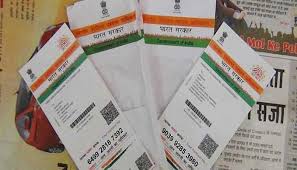 After making Aadhaar mandatory for filing income tax returns and applying for a permanent account number (PAN), the government has moved to make Aadhaar-based e-KYC (know your customer) mandatory for mobile phone connections.
After making Aadhaar mandatory for filing income tax returns and applying for a permanent account number (PAN), the government has moved to make Aadhaar-based e-KYC (know your customer) mandatory for mobile phone connections.
In a notification late Thursday, the department of telecommunications (DoT) directed all mobile phone service providers to reverify existing customers, prepaid and postpaid, using their unique Aadhaar identity number and biometric details. They were told to complete the exercise by early next year.
Aadhaar-based e-KYC would also be mandatory for customers procuring new SIM cards.
It is another step towards making the use of Aadhaar all-pervasive in a country where it is already being used to better target beneficiaries of some government subsidies and welfare programmes.
On Tuesday, the government said Aadhaar would be mandatory for filing income tax returns as well as for obtaining and retaining the permanent account number (PAN) that taxpayers need to quote in their returns. From 1 July, every taxpayer will have to quote Aadhaar while applying for a PAN and when filing tax returns. Existing PAN holders will have to disclose their Aadhaar numbers to the government by a date that will be specified later. In case they fail to intimate their Aadhaar number, taxpayers will have the PAN allotted to them deemed invalid.
The move to link mobile phone connections to Aadhaar, administered by the Unique Identification Authority of India (UIDAI), comes after the Supreme Court said in February that all phone numbers in India should have verified users. The court said this during a hearing on a case brought by Lokniti Foundation, a non-profit organization.
Although the Supreme Court stopped short of saying that Aadhaar has to be used to verify users, the government seems to have decided that linking the unique identity number to mobile connections will be the best way to go about this.
“A meeting was held on 13.02.2017 in the department with the telecom industry wherein UIDAI, Trai and PMO representatives also participated to discuss the way forward to implement the directions of Hon’ble Supreme Court,” said the notification issued by DoT.
Trai is short for the Telecom Regulatory Authority of India and PMO for the Prime Minister’s Office.
Any unverified mobile phone number, or any number that is not linked to Aadhaar, will be illegal after 6 February 2018.
The government has directed telecom companies to intimate their existing subscribers about the re-verification process through all means possible, including through advertisements in newspapers and text messages.
The licensees have also been directed to send a “verification code” to the mobile numbers of subscribers to ensure that SIM cards are physically available with the subscribers before initiating the e-KYC process.
“I am unclear about the benefit that will arise out of the exercise where we will have to re-evaluate all the subscribers,” said Arpita Pal Agarwal, partner and leader—telecom industry practice—at consultancy PricewaterhouseCoopers India Pvt. Ltd. “It will add additional costs to the (telecom) sector, which it at the moment cannot afford.”
The Supreme Court previously said in an interim ruling that the use of Aadhaar should not be mandatory in delivering government benefits. Hearings in the case and a final ruling are still pending. The legislation that conferred statutory status on the Aadhaar project too said its use wouldn’t be mandatory.
“The government can decide with the legislature on making Aadhaar compulsory for the various schemes or activities. However, I don’t understand why are they making it compulsory for some schemes on their own when a decision is still pending before the Supreme Court. They can be easily challenged,” said Rahul Matthan, partner at law firm Trilegal and a Mint columnist.
According to former rural development secretary N.C. Saxena, the delivery of benefits offered by government schemes should be linked to Aadhaar.
“Aadhaar should become compulsory as it will help government check corruption. I don’t know why people are against it. We can start making Aadhaar compulsory one scheme at a time, see its impact and then extend it to other schemes,” he said.
Source: http://www.livemint.com/Industry/wyGskI48Ak73ETJ5XW0diK/Aadhaar-now-a-must-for-all-mobile-phone-connections-after-ta.html




